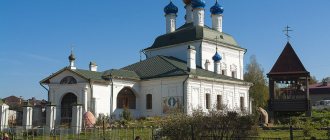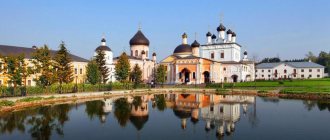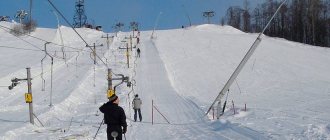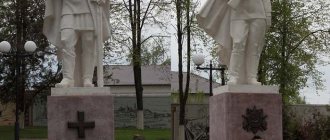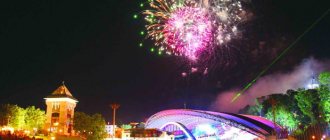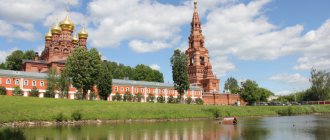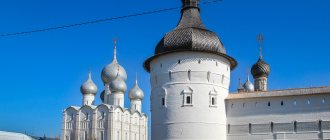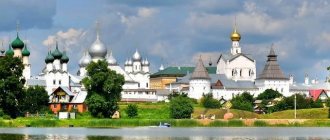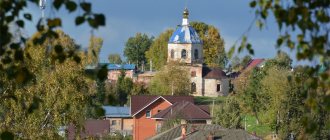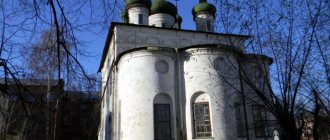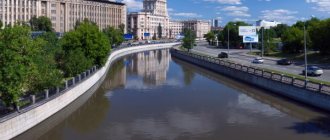Borovsk is a historical city in Russia, which is little explored by tourists. In its extraordinary landscapes and seemingly inconspicuous streets, the city preserves amazing architectural monuments, unique frescoes and the little-studied culture of the Old Believers. The mystery and deep history of Borovsk captivates and will not leave any visitor to this city indifferent.
The centuries-old history of Borovsk is simply fascinating. The exact designation of when the city was founded is still not known for certain, but ceramics were found , which dates back to the 11th - 13th centuries. The first mention of the city dates back to 1358. Surprisingly, Borovsk has managed to preserve not only its historical layout, but also its rich cultural heritage to this day. Thanks to this, he never tires of inspiring many artists and poets to create creative masterpieces.
Description and history of Borovsk
Borovsk is one of the oldest cities in Rus', which amazes with the number of attractions that have been preserved since the founding of the city.
It is located along the Protva River. Borovsk is the northernmost city of the Kaluga region, it is located 85 km from the southwestern region of Moscow, and 106 km from the regional center of Kaluga. The local population in 2022 was 10,734 people. The city abounds in coniferous trees and is surrounded on all sides by pine forests, which is why it is named “Borovsk”. The official founding date is considered to be 1358. This year Borovsk was mentioned in the chronicle of the prince, Ivan 2 Ivanovich the Red (Merciful), son of Ivan 1 Danilovich Kalita.
But there are 3 facts that cast doubt on the conclusion of historians:
- One of the ancient chronicles indicates the date of construction of the Church of the Intercession in Vysokoye Selo in 1146. At the same time, the baptism of the Slavs took place on the Protva River, and the Borovets (Borovsk) fortress was erected in the bend of the river.
- On the territory of Borovsk, during excavations, household items and ceramics were discovered dating back to an earlier period, the 11th – 13th centuries.
- The chronicle of Grand Duke Vasily Dmitrievich from 1390 speaks of the city of Borovsk as a fully formed appanage principality with an established internal order.
Historical events in Borovsk:
| 1378 | By decree of Prince Dmitry of Moscow, the city was transferred to Prince Vladimir of Serpukhov. |
| 1380 | Vladimir (Serpukhov-Borovsk prince) during the Tatar-Mongol attack sided with Prince Dmitry and played an important role in the Battle of Kulikovo. |
| 1480 | During the period of the “Great Standing on the Ugra” (the confrontation between Prince Ivan 3 of Moscow and Khan of the Great Horde Akhmat), Borovsk served as a defensive point on the southwestern borders of Moscow. |
| 1508 | During the Russian-Lithuanian War, Borovsk was transferred to the military leader and statesman Prince Mikhail Glinsky. |
| 1566 | Borovsk was transferred by Ivan the Terrible to Vladimir Staritsky. |
| 1600 – 1618 | In the "Time of Troubles", especially 1606 -1607. During the peasant war, Borovsk was severely destroyed. |
| 1634 | During a strong fire, the fortress was destroyed, which is why Borovsk lost its status as a defensive point and began to develop in trade. |
| 1666 | As a result of a split in the church, the sisters, noblewoman M.F. Morozova and princess E.P. Urusova, were exiled here. |
| 1777 | Approval of the city coat of arms of Borovsk. |
| 1812 | The city was ravaged and burned by Napoleon's retreating army. |
| 1860 | The famous thinker N. F. Fedorov lived and taught history in Borovsk. |
| 1880 – 1892 | The founder of astronautics, K. E. Tsiolkovsky, lived and taught mathematics in the city. His scientific works were written during the same period. |
| 1941 | The city was captured by the Nazis, its occupation lasted until January 4, 1942. |
Top 10 most interesting sights of Borovsk
Borovsk, whose sights are distinguished by their primitiveness and uniqueness, was included in the list of historical cities of Russia in 2000.
List of attractions:
- St. Pafnutev Borovsky Monastery. The monastery was founded by Saint Paphnutius, in worldly life Parthenius, who took monastic vows at the Vysoko-Pokrovsky Monastery in 1414. In 1444, Paphnutius and his disciple left the walls of the Intercession Monastery in search of solitude, but a string of like-minded people followed them. This is how a men’s monastery was formed called the Pafnutiev Monastery of the Nativity of the Blessed Virgin Mary. With donations from the clergy, the hermits built churches and temples. In the spring of 1477, the Monk Paphnutius died, he was canonized “as a saint,” and was buried near the main church of the monastery.
- Frescoes of Borovsk. A distinctive feature of Borovsk is the frescoes on the facades of ancient houses and fences. At the beginning of the 21st century, the artist, local historian and public figure V. A. Ovchinnikov moved from Moscow to Borovsk with his wife, poetess Elvira Chastikova. At some point, the artist decided to paint the dull walls of buildings, and his wife accompanied each drawing with a poem specially written for this illustration.
- Church of the Intercession of the Blessed Virgin Mary. The temple (or “Borovsk Kizhi”) is inextricably linked with the history of Paphnutius and the emergence of the Holy Paphnutian Monastery. It was in this temple that the Borovsk wonderworker Paphnutius served for 30 years (from 1414 to 1444). The Church of the Intercession of the Holy Virgin is made of wood without a single nail, but despite this, it has been perfectly preserved to this day, although usually such buildings require restoration after 200 years.
- Cathedral of the Annunciation of the Blessed Virgin Mary. The cathedral is located near the central square of the city on a hill above the Protva River. This is one of the oldest temples built of stone. The date of foundation of the cathedral is unknown for certain, but in ancient times the cathedral was made of wood. The cathedral is an important landmark of the city and is called the “Cathedral of the Kaluga-Borovsk diocese.”
- Temple of Boris and Gleb. 1 mention in the records of the “temple of Boris and Gleb” appeared in 1610. It was described that the wooden church burned out during a fire, and in 1621 it was restored. On the site of the wooden temple, a stone one was erected in 1704. The erected temple, erected in honor of the holy noble princes Boris and Gleb, is recognized as a monument of federal significance.
- Cathedral of the Intercession of the Blessed Virgin Mary. The official founding date of the church dates back to 1912. The Revolution of 17 did not make it possible to complete the interior decoration, and the cathedral was abandoned. In the 30s, due to its large area, the cathedral was used as a car garage and warehouses. Until the beginning of the 21st century, it was part of the Borovsk vehicle fleet. In the fall of 2005, it was decided to transfer the cathedral building to the Old Believers to house a nunnery there.
- Temple of Dmitry of Thessalonica. The Church of the Great Martyr Demetrius of Thessalonica is located in the village of Ryabushka, Borovsky district. It was built in 1804 from stone. In the hall there are wooden statues of the “Mother of God” and “Mary Magdalene”, and an image of the Great Martyr Demetrius hangs. Near the temple there are 2 consecrated springs, to which people from all over the area flock at Epiphany.
- Monument to K. E. Tsiolkovsky. The monument to Tsiolkovsky was erected in 2007 on the main street of the city to mark the 150th anniversary of the scientist. The bronze composition by S. Bychkov weighs 600 kg and consists of a sculpture of Tsiolkovsky looking up and a rocket taking off nearby. Before Bychkov’s composition, a bust of the scientist was located here.
- Monument to Admiral D.N. Senyavin. In 2013, in the park on the street. Lenin erected a monument to the Russian military leader, the legendary Admiral D.N. Sinyavin. He commanded the Baltic Fleet, was a participant in the Russian-Turkish War, opposed Bonaparte and became the winner of the Battle of Athos. He was born in the village of Komleve in the Borovsky district into a family of hereditary military men.
- Monument to St. Paphnutius. In 2016, a monument to the wonderworker and founder of the St. Paphnutius Monastery Paphnutius Borovsky was erected near the Church of the Most Holy Theotokos. It is made of bronze by sculptor Alexei Leonov. In the future, the monument will be placed on a pedestal and a chapel will be built nearby.
Religious shrines of Borovsk
There are many churches and temples in the city. But it all began with the construction of a monastery by the Monk Paphnutius.
Pafnutev-Borovskaya monastery
- Address: st. Dmitrova, 1.
The monastery was founded in 1444. It is located on a hill at the confluence of the Isterma and Protva rivers. In 1467, a new stone cathedral was built on the site of the first, Church of the Nativity. It stood for more than a century, until 1586. Instead, by order of Fyodor Ioannovich, a five-domed temple was erected.
The monastery was turned into a fortress in the 16th century, building powerful stone walls and fortifications. At the same time, a stone refectory and belfry were erected, which were replaced by a bell tower in 1688.
In the 17th century, events taking place on the territory of the monastery changed with kaleidoscopic speed. In 1610, the walls of the monastery could not withstand the assault of the Poles. Enemies burned the conquered monastery. At the end of the Time of Troubles, it was restored, but then the times of the Schism of the Church began.
In the 1640s, Hieromonk Polyeuctus and Bishop Paul were executed because they did not support the innovations of Patriarch Nikon. 20 years later, Archpriest Avvakum, one of Nikon’s main opponents, was imprisoned in a prison at the monastery. Here, in 70 of the 17th century, the noblewoman Morozova and her sister, Princess Urusova, who supported Avvakum, languished.
After Nikon's reforms, the monastery began to decline. Under Catherine II, 33 novices remained here, and the monastery was deprived of almost all of its estates. During the Patriotic War of 1812, the French burned it, but the monastery was quickly restored.
In Soviet times, there was first a correctional facility here, then a technical school. Later, the monastery came under the jurisdiction of the Borovsk Local History Museum. The monastery was returned to believers in 1991. Nowadays it is a functioning men's monastery. It is also open to visits from the lay population.
Church of the Intercession of Our Lady on Vysokoye
- Address: Rabochaya st., 41.
The history of the temple began with the Vysoko-Pokrovskaya Borovskaya monastery. It was founded in 1410. The Monk Paphnutius became a monk in the monastery. Since 1618, the monastery was assigned to the Pafnutyevo-Borovsky Monastery. Almost a century and a half later, in 1764, it was abolished.
Until the time of impostors came, there were 2 churches here - a stone one, the Intercession of the Most Holy Theotokos, a wooden one, in the name of the Entry of the Lord into Jerusalem. This temple had a refectory for monastery novices.
Now, on the site of the monastery, there is a small wooden church. The Intercession Church of the Blessed Virgin Mary is mentioned in church inventories in 1701 and 1763. The shrine building is built on a cobblestone foundation. Its walls are made of pine. The outer cladding of the temple was changed several times, and the roof of the structure, made of planks, was replaced with iron.
The authorities took the church away from believers in 1932. The temple was returned to parishioners in 1994. Since 1999, it has the status of a metochion of the St. Paphnutievsky Monastery. Since 2008, restoration work has been carried out here. The temple was consecrated in 2010.
Blagoveshchensky cathedral
- Address: st. Lenina, 1.
Accurate information about the time of construction of the oldest part of the church has not been preserved. Historians date the appearance of the cathedral to the 17th-18th centuries. The wooden church was located in the fortress.
After the events of the Time of Troubles, the temple was moved to the city's market square. The church became stone. During the Patriotic War of 1812, the temple was desecrated and looted. Thanks to the efforts of Archpriest Simeon (Zverev), by 1819 a refectory and a bell tower were erected. The refectory had 2 side-chapels. Southern - consecrated in 1819, in honor of St. Nicholas the Wonderworker. Northern - Kazan Icon of the Mother of God, consecrated 10 years later.
In the middle of the 19th century, an iconostasis of 5 tiers appeared in the temple, the refectory and porch were decorated, and bells were installed. Annunciation Cathedral is a cathedral. Therefore, the Royal Doors are overshadowed by the archpastoral staff.
The Council did not escape persecution during the struggle against religion. But even in those days, services were held there. During the war years, the sanctuary was desecrated by the Nazis. During one of the attacks, a shell hit the bell tower of the cathedral, but there was no explosion. Believers attribute this event to a manifestation of God's Providence.
The temple is an active religious site. Its main shrines are the image of St. Nicholas, carved from wood, the image of St. Paphnutius and His staff. The Kazan Icon of the Mother of God and the reliquary image have also been preserved. It contains particles of the Cross and the Holy Sepulcher, the relics of 18 saints.
Church of Boris and Gleb
- Address: Kommunisticheskaya st., 102.
Boris and Gleb Church was built in 1704. Initially, it was a traditional five-domed church. In 1819, a three-tier bell tower was added to the cathedral. She was crowned with a small dome.
During Napoleon's invasion, the temple was turned into a stable. Because of the missing stallion, they wanted to destroy the church and execute the hostages. To prevent this from happening, a certain Titus took all the blame upon himself. The invaders drowned an innocent man in a pond, but all the other townspeople survived. The temple has also been preserved.
The cathedral was closed in 1929. The return of the church to believers took place in 1985, at which time its restoration began. Worship services have been held since 1993.
Now the cathedral greets believers with a renewed façade and beautiful interior decoration. At the entrance there are two fonts with spring water. There is a sincere atmosphere here. There are a lot of toys in the children's corner and an aquarium. Parishioners, coming with children, can safely leave them under supervision and go to prayer.
Among the shrines, the temple contains the relics of Saints Gleb and Boris, John the Baptist and others. Parishioners worship the icons of the Kaluga and Iveron Mother of God. Particles of the relics of the righteous Saint Matronushka are especially revered by believers.
Intercession Cathedral of the Blessed Virgin Mary
- Address: Kommunisticheskaya st., 63.
The church building was built at the beginning of the 20th century. (from 1909 to 1912). This temple is a building in the neo-Russian architectural style. It has 5 domes and a pillar-shaped bell tower. The cathedral was built at the expense of the local merchant N. Zhdanov. Initially, it was transferred to the ownership of the non-okrug community. The temple has a second throne - St. Nicholas.
The authorities closed it in 1929, during the days of religious persecution. Since 1998, the Cathedral of the Most Holy Theotokos has been in the possession of the Old Believer community. It was decided to create a women's monastery here in 2005. She began to bear the name of the holy confessor Theodora (Morozova). Restoration work is underway in the temple, but due to a quarrel with the local administration, it may be delayed.
Vvedenskaya Old Believer Church
- Address: st. Tsiolkovsky, 10.
Despite the large number of churches of the new rite, in Borovsk there are many parishioners who profess the Old Believers. The Vvedensky Church was built in 1908. It was a one-domed brick building in a pseudo-Russian architectural style. Later, in 1912-1914, a tented bell tower was added.
There was a Sunday school at the cathedral. Znamenny singing was taught here. The church was closed in 1930. Rituals and services were held at home. During the fascist occupation, the temple was allowed to be renovated and services held in it. It didn't last long. Soon the Germans turned the church into a prison. It held prisoners of war.
After the war, grain and vegetable storage facilities were built here. The structure was then used as a hatchery station. The Vvedenskaya Church was returned to the fold of Orthodoxy in 1989. It was restored and consecrated in 1990. Since 2015, bells have been installed on the temple. Nowadays services are accompanied by their chime.
Church of the Transfiguration of the Lord "on Vzgorye"
- Address: st. Uritsky, 15.
The first mention of the temple says that in 1610 the Spasopreobrazhensky Church was located on Spasskaya Street. During the raid, it was burned by “Crimean people.” About the new cathedral, in documents from 1746, it is written that it was a wooden structure.
The stone church building was built with the money of a merchant from Moscow V. Prosvirin (according to other sources - Prosvirnin). The Transfiguration Church has two chapels. One of them is dedicated to the Protection of the Most Holy Theotokos, and the second to Peter and Paul.
The cathedral was badly damaged during the fire of 1857. The damage amounted to more than 1,700 rubles, but parishioners collected the required amount and restored the temple.
The church parish of the Transfiguration Cathedral was one of the richest in Borovsk. The revolution of 1917 changed a lot. The temple was deprived of its property, and its tenement buildings were given over to apartments for the townspeople. The church was completely closed in 1923.
Almost 90 years later, the cathedral returned to the believers. The first service was held here in 2009. Although the temple is considered operational, it still has a long way to go to regain its former grandeur.
Church of the Archangel Michael
- Address: Borovsky district, Krasnoye village.
The Arkhangelsk Church was built in the village. Krasnoe, near Borovsk. The stone temple appeared in 1910, thanks to the efforts of the Zembulatov family of merchants and church warden V. Chelishchev. It had a chapel in the name of St. Nicholas the Wonderworker.
It was placed next to the wooden cathedral, which had been in these places since 1774. According to various sources, the old temple began to be dismantled immediately after the appearance of the new building. But some evidence says that the wooden church could still be seen in the 20s of the last century.
Almost the entire life of the Arkhangelsk Church passed during the Soviet system. The first seizures of valuables and shrines of the temple were carried out in 1922. The Great Patriotic War also caused damage to the cathedral. Worship services reopened in 1944.
This continued until the end of the 50s. In 1959, the church was closed, and in 1960 it was deregistered as an active religious site. During these times, the greatest damage was caused to the temple building. At first, the church premises were used for various needs, later local summer residents began to tear away the church building literally brick by brick.
Hard times ended in 1994, when the Cathedral of the Archangel Michael was returned to the believers. Its restoration has begun. In 2008, a priest was appointed to the parish. Parishioners hope that this beautiful and slender church will again become one of the iconic places in Borovsk.
Church of the Exaltation of the Holy Cross
- Address: st. Volodarsky, 56.
The history of the temple began even before the Time of Troubles. In 1647, the Cathedral of the Exaltation of the Cross was erected on the lands of the former Church of Simeon the Stylite. The temple did not serve believers for long - after the death of the abbot it was closed.
After a while, instead of the dilapidated cathedral, a new church was built in 1700. In 1764, the Intercession Church from the abolished monastery and the Sretensky Cathedral from Vysotskaya Sloboda were assigned to it.
Construction of the stone church began in 1800, but the work was not completed due to the invasion of Napoleon. After the enemy was expelled, thanks to the help of parishioners, the temple was completed and dedicated to the victory over the French. The cathedral was built in the style of classicism. He had 3 thrones.
The Church of the Exaltation was open to parishioners until 1925, when it was closed by the authorities. During the Soviet years, the temple had the opportunity to serve as a machine and tractor station, a grain warehouse, and in the post-war years - a water tower.
The restoration of the church began in the 90s of the 20th century. Since 2007, it has again passed to believers. The temple holds infrequent services. Restoration of the Cathedral of the Holy Cross continues.
Nativity Church of the Blessed Virgin Mary
- Address: st. Dmitrova, 1.
The temple is located in Roshchinskaya Sloboda. It was built in 1708. It was an unheated quad and a warm refectory with stove heating. In winter, only the warm part of the church was open. The Nativity Cathedral had 3 altars and, together with the adjacent cemetery, was surrounded by a stone fence.
The main iconostasis consisted of 5 tiers. It was decorated with wooden carvings and a gilded chasuble. In the church there was the Iveron Icon of the Mother of God, brought from Holy Mount Athos. The parishioners venerate the image of the Lord Pantocrator and the icon “Quench My Sorrows.” In the temple, one of the utensils is a small format Gospel. It was printed back in 1668, during the time of Tsar Alexei Mikhailovich.
In 1840, at the expense of a merchant from Moscow I. Volkov, an almshouse was built at the Nativity Cathedral. Here (until 1905), the zemstvo school operated. It was a one-class school, and only boys studied there.
The temple was lucky - services were held here, even in Soviet times, although with short interruptions. After World War II, the Church of the Nativity of the Blessed Virgin Mary was no longer closed. Now services are held on a regular basis.
Old Believer Chapel
- Address: Sovetskaya st., 6.
The chapel was conceived as a monument to the martyred sisters who suffered for their orthodoxy. This building was erected in 2005 with funds from the Old Believer community of Borovsk.
The idea of building a monument to Theodora Morozova and Evdokia Urusova arose at the beginning of the last century. The plans could not be realized - first there was the First World War, then the October Revolution and years of church persecution occurred.
The question of building a chapel was returned to at the end of the 20th century. In 1996, the community was allocated land on Gorodishche, and a committee was created to build the monument. Now the chapel is a symbol of the Old Believers and glorifies the sisters who accepted martyrdom for their faith.
The building consists of a central and 4 small domes. The chapel has 2 parts. In the upper part, the martyrs are glorified for their piety, and in the underground part of the structure there is a symbolic pit in which the sisters ended their earthly days. There is also a tombstone from their resting place.
Topic: Sights of the Kaluga region
Architectural objects and monuments of Borovsk
A huge number of interesting architectural and historical objects have been preserved in Borovsk.
Chapel of Boyarina Morozova
The chapel, erected in memory of Feodosia Morozova and her sister Evdokia Urusova, is located on the site of the ancient Settlement, on the street. Soviet. This is the tragic story of 2 sisters who were martyred during the schism of the church in the mid-17th century.
In 1905, after the adoption of freedom of religion, a procession of the cross came to the graves of the sisters, as if they were visiting the holy great martyrs. At the beginning of the 21st century, at a meeting of Old Believers of the Orthodox Church, they decided to erect a chapel dedicated to 2 sisters.
Officers' meeting in a merchant estate
An ancient merchant estate, built in the 19th - 20th centuries, is located in Borovsk on the street. Lenin. Along the street is the main estate, which previously belonged to the ancient merchant family of the Sanins. The estate consists of a courtyard area and a garden.
At the beginning of the 20th century, the estate was purchased by an officers' meeting. During his stay in Borovsk, the Emperor Grand Duke Mikhail Alexandrovich, the brother of Emperor Nicholas II, honored the estate with a visit.
Shokin Estate
Shokin’s estate or “lace house” is the most beautiful building in Borovsk, which since 1987 has the status of a cultural heritage site of regional significance. It was built at the end of the 19th century and is located on the street. Lenin.
Borovsk has historical sights such as the Shokin estate.
The building is 2-storey with turrets on the roof, the 1st floor is made of solid stone, the 2nd floor is wooden and decorated with openwork carvings. The merchant Shokin, who built the estate, was a respected man, a builder of churches and a member of the Borovsk City Duma.
Historical monuments of Borovsk
Borovsk, whose attractions, ancient houses and estates with an interesting history, arouse great interest among tourists.
House of merchant Bolshakov
The 3-story stone building of the early 18th century was considered the richest building of that time. The attraction is under state protection. According to records, this house-museum belonged to the Bolshakov-Pisarev merchant dynasty.
At various times, Emperor Napoleon, Grand Duke Alexander Nikolaevich, Emperor Alexander 1, Prince Mikhail Alexandrovich stayed in the house.
Merenkov merchant house
The house of the merchant Merenkov was built at the end of the 19th century. This is a 2-storey house, the 1st floor is stone, the 2nd is wooden. Thanks to the ornaments that decorated the facade, the house became a historically significant object, but recently, due to the lack of reconstruction and repair, the house has become dilapidated, and there is an opinion that the building may be demolished.
The decoration and communications in the house at the beginning of the 20th century were considered super-modern; the house had electricity and sewerage. The building currently houses a police station.
Merchant estate of the Sanins
The estate was built in the 19th century by city activists the Sanins. The 2-storey manor consists of a stone 1st floor and a wooden 2nd floor. Currently, the outbuilding, barn and main house have been preserved. Now the estate has been turned into an apartment building and since 1991 it has been included in the list of objects that have the characteristics of a cultural heritage site.
City architecture of Borovsk
In a small town in the center of Russia there are several architectural structures worthy of the attention of tourists.
Shokin Estate
- Address: st. Lenina, 15.
This building has another name - the Lace House. It is considered the most beautiful in Borovsk. Its facade attracts with its beauty and some kind of mystery. The house, built in the first half of the 19th century, is separated from the street by a high fence. There are 2 small towers in the estate - one next to the house, the second in the yard.
The stone first floor is decorated with rusticated inserts. On the second floor there are wooden carvings reminiscent of lace. The pediment is decorated with a small, fairy-tale attic window.
Now the estate houses the exhibition hall of the “School of Masters”. Its exhibition features Borovsk embroidery, ceramics, rag dolls and other works of folk craftsmen who do not allow traditional crafts to die.
House of merchant Bolshakov
- Address: Lenin street, 12.
The building is located in the city center. It was built at the end of the 18th century. Retreating French troops passed through Borovsk twice in 1812. The city was almost destroyed, but Bolshakov's house was lucky to survive. Legends say that this was the refuge of the fleeing Napoleon, which is why the building has been preserved.
In Soviet times, Bolshakov's house was used for various institutions. Now the building is in an abandoned state. Restoration work began several years ago. But restoration is being carried out at a very slow pace. No one knows when the building will return to its previous form.
Urban murals
- Address: Lenin Square, 2.
The enthusiastic artist V. Ovchinnikov lives in Borovsk. Using his own funds, he creates paintings on the walls of houses that tell about the history of the city. Now there are more than 100 of these frescoes. His sketches not only show the events that once took place in these places, but also decorate city buildings, giving them their own, unique look.
Interesting museums in Borovsk
You can get acquainted with the sights of the ancient city of Borovsk by examining the exhibits of local museums.
Borovsk Museum of History and Local Lore
The museum was founded on July 1, 1987. The main exhibitions are dedicated to the history and culture of Borovsk. The museum contains a collection of household items, ancient photographs of the city, and a numismatic collection of the 16th-20th centuries. The history of the creation of religious temples and cathedrals.
A separate exposition of the Second World War on the territory of Borovsk.
The museum's library contains more than 8 thousand copies of ancient books and chronicles. Collected exhibits related to famous people living in Borovsk over the years.
Museum-apartment of K. E. Tsiolkovsky
From the beginning of April 1887 to November 1888 at the address st. Kruglaya (Tsiolkovsky St.) in house 49, on the 2nd floor of the house lived the founder of astronautics, the famous inventor K. E. Tsiolkovsky. Initially, the museum was founded in the 60s on a voluntary basis, existed for several years and closed.
In the 80s they decided to recreate the museum. On September 19, 1997, the 2nd floor of the house that Tsiolkovsky occupied was restored and now welcomes guests with exhibits of the scientist’s life and everyday life. In total, Tsiolkovsky lived in Borovsk for 12 years.
Museum and Exhibition Center
The art gallery of the museum and exhibition center was created at the end of the 20th century with the participation of artists Mironov and Soldatenkov. The museum is located in a historically significant site, the Church of All Saints. Along with painting exhibitions, the museum can see works of folk art and photo exhibitions.
House-Museum of the Polezhaevs
The building was built at the beginning of the 19th century by the manufacturer Polezhaev, who in 1887 founded a weaving factory called “P. M. Polezhaev and K.” The factory specialized in the production of scarves, which were sold far beyond Borovsk. After the revolution, the factory received the name “Red October”; in the 90s, the factory was renamed “Runo” and continues to operate to this day.
The descendants of the manufacturer set up a museum of their ancestors in the house, which presents:
- personal belongings;
- photos;
- letters;
- furniture;
- household utensils;
- embroidery.
In total, the museum has 1,500 thousand exhibits.
Education
Municipal educational institution "Secondary school No. 1 of Borovsk"
Borovsk, st. Lenina, 26 Phone: 8 (48438) 4-32-26, 4-39-15, 6-63-61
Municipal educational institution "Secondary school No. 2 of Borovsk"
Borovsk, st. Lenina, 47 Phone: 8 (48438) 4-39-58
Municipal educational institution "Evening (shift) secondary school"
Borovsk, st. Kommunisticheskaya, 3 Phone: 8 (48438) 4-39-49
Municipal educational institution "Secondary general education noospheric school"
Borovsk, st. Bolshaya, 38 Phone: 8 (48438) 4-35-32
Municipal educational institution "Secondary school No. 4, Borovsk-1"
Borovsk-1 Phone: 8 (48438) 4-41-78
MDOU "Kindergarten No. 3 "Ryabinka"
Borovsk, st. Kommunisticheskaya, 69 Phone: 8 (48438) 4-41-24, 6-63-51
MDOU "Kindergarten No. 4 "Brigantine"
Borovsk, st. Mira, 62a Phone: 8 (48438) 4-18-90, 4-42-68
MDOU "Kindergarten No. 5 "Yablonka"
Borovsk, st. Kommunisticheskaya, 15a Phone: 8 (48438) 4-42-27
MDOU "Kindergarten No. 8 "Caramel"
Borovsk, st. P. Shuvalova, 18 Phone: 8 (48438) 6-63-60
MDOU "Kindergarten No. 16 "Topolek"
Borovsk, Institute village Telephone: 8 (48438) 6-62-67, 6-61-80
Temples and cathedrals of Borovsk
Borovsk is famous for its ancient Orthodox Old Believer churches and cathedrals.
Old Believer Church of All Saints
The church was founded at the end of the 19th century, construction continued until 1909. The church is located on Lenin Street, built of brick, with a high bell tower and domes. In 1928, the church ceased to function as an Old Believer temple. In the 70s, the façade of the church was restored.
Currently, the temple is used as an art gallery of Borovsk and a cultural center.
Church of the Exaltation of the Holy Cross
The first mention of the Temple appeared in chronicles in 1650. The wooden temple at that time was built at the intersection of Volodarsky and Mira streets. For a long time, no services were held in the Temple due to the absence of a priest, and the abandoned temple fell into disrepair over time.
In 1812 it was looted and burned by Napoleon's army.
A brick church was erected next to the wooden church, but during the bombing of the Second World War it was damaged and was not used for its intended purpose for a long time. In the early 90s of the 20th century, the artist L. G. Kiseleva began restoration work, which continues to this day.
Church of the Transfiguration of the Lord on Vzgorye
In the center of Borovsk, on the square, there is a temple “on Vzgorye”. This is a brick building with 1 bell tower, built of brick at the beginning of the 19th century by the merchant V.S. Prosvirin. In the 20s of the 20th century, the temple was closed and used as a warehouse.
In the 80s of the 20th century, the temple was restored and transferred to the diocese. In 2001, the temple was annexed to the Annunciation Cathedral, and in 2007 it was transferred to the Pafnutiev Monastery.
Church of the Entry of the Blessed Virgin Mary
The temple was erected on the outskirts of Borovsk in 1908 and named Pokrovsky. In 1915, a bell tower was built on the temple. At the beginning of the war it ceased to function; German militias used it as a prison for captured soldiers.
In the post-war period, grain and vegetables were stored in the temple. In the early 90s, it was transferred to the Borovsk Old Believer community and its reconstruction began, which continues to this day.
Parks and gardens of Borovsk
Borovsk is located in a very picturesque place, the city has many trees and green park areas.
City square
In Borovsk, on Sovetskaya Street at the foot of the Settlement, there is a small green square with a fountain.
It is equipped with gazebos and benches, flowers are planted and a monument to Yu. A. Gagarin is installed in the center.
Park area
In the center of the village of Krivskoye, Borovsky district, a park area was opened in 2022. The large area is equipped with benches and trees and shrubs are planted. For children's recreation and entertainment, a separate area for cycling and roller skating was fenced off and paved.
Park and garden of the Pafnutev-Borovsky Monastery
On the right bank of the Isterma River, northwest of the monastic buildings, there is the park and garden of the Pafnutiev Monastery. The main attraction of the garden is a cascade of 3 ponds separated by small dams. Pine and linden trees grow along the coastline. The park has been awarded the status of a “Nature Monument”.
Social Services
Department of Social Protection of the Population
Borovsk, st. Sovetskaya, 5 Phone: 8 (48438) 4-32-43 (manager)
Center for Social Services for Elderly and Disabled Citizens
Borovsk, st. Lenina, 22 Phone: 8 (48438) 4-16-01, 4-27-61, 4-25-61
Center for social assistance to families and children "Harmony"
Borovsk, st. Sovetskaya, 6 Phone: 8 (48438) 4-42-15, 6-62-69
State Institution "Employment Center of the Borovsky District"
Borovsk, st. Lenina, 74a Phone: 8 (48438) 4-30-49, 4-26-81, 4-30-59
Modern objects interesting to visit
Borovsk, whose attractions consist not only of ancient temples and cathedrals, bears the honorary title “City of Military Valor”.
Stele "City of Military Glory"
In honor of the city of Borovsk being awarded this title, a stele was unveiled in 2022. The city received the title for courage and dedication during the war on the territory of Borovsk.
The location of the stele was chosen by a majority vote of local residents. The stele was installed at the entrance to the regional center.
Memorial stone to the heroes of the Battle of Kulikovo
The sculpture was installed on the steep bank of the Protva River in 2011 by a local resident of Borovsk, Boyko Alexander. The sculpture is a huge irregularly shaped stone with a sign indicating the date of the Battle of Kulikovo and describing this event. The monument is dedicated to Prince Mikhail the Brave, Mikhail Brenka and the Borovsk residents, who showed themselves to be brave and loyal warriors.
Monument to Yuri Gagarin
The monument to Yu. A. Gagarin in Borovsk was erected in 2011. The bust of 1 cosmonaut is made of bronze and installed on Kommunisticheskaya Street. The sculptor shows Gagarin looking with interest from the ship's porthole at the receding earth.
Monument to N.F. Fedorov
The monument was erected in 2009 in memory of the great thinker and philosopher who worked and lived in Borovsk at the end of his life.
The monument was erected at the expense of the charitable organization “Dialogue of Cultures - One World” for the 180th anniversary of Fedorov, according to a sketch by the sculptor A. Vlasov, made from a portrait of the artist L. Pasternak.
Coat of arms
The coat of arms of the urban settlement "City of Borovsk" was approved by decision No. 67 of the City Duma on July 26, 2006 and entered into the State Heraldic Register of the Russian Federation with the assignment of registration number 697.
It is a silver heraldic shield on which there is a red heart with a gold cross, surrounded by a green laurel wreath.
The coat of arms of Borovsk was developed on the basis of the historical coat of arms of the district town of Borovsk, Kaluga province.
The use of a historical coat of arms by a modern city symbolizes the continuity of the history of the city’s development, the preservation of traditions and the memory of the glorious deeds of our ancestors.
Yellow color (gold)
A symbol of wealth, stability, respect, warmth.
White color (silver)
A symbol of purity, perfection, peace and mutual understanding.
Red color
A symbol of courage, strength, life-affirming energy, celebration and beauty.
Green color
Symbol of nature, health, growth.
The historical coat of arms of Borovsk (1777) was reconstructed by the Union of Heraldists of Russia.
Authors of the reconstruction of the coat of arms
Idea
Konstantin Mochenov (Khimki)
Artist
Robert Malanichev (Moscow)
Computer design
Galina Rusanova (Moscow); Sergey Isaev (Moscow)
Rationale for symbolism
Kirill Perekhodenko (Konakovo).
On October 4, 2005, the Bank of Russia issued a commemorative coin with a face value of 10 rubles, from the Ancient Cities of Russia series, on the reverse of which the coat of arms of Borovsk is depicted.
Excursion routes
Excursion with lunch in merchant's style costing 2200 rubles:
- excursion around Borovsk, viewing frescoes on the facades of buildings;
- chapel of noblewoman Morozova;
- house - Tsiolkovsky museum;
- visit to the estate of the manufacturer Polezhaev;
- Pafnutev Monastery and Park;
- lunch in the fresh air on the observation deck of Borovsk.
Excursion costing 1500 rubles:
- walking tour through the center of Borovsk, getting to know its architecture;
- trip to the Vysoko-Pokrovsky Monastery;
- Church of the Intercession of the Blessed Virgin Mary;
- visit to the observation deck and holy spring;
- trip to the Pafnutev Monastery.
Holy waters of Borovsk and surrounding areas
There are underground springs in the city and its environs. Their waters are considered holy. They heal and encourage all believers.
Source at the Church of the Intercession of Our Lady on Vysokoye
- Coordinates on the map: 55.208666, 36.505909.
On the right bank of the Protva River there is a spring revered by believers. It is consecrated in the name of the Intercessions of the Most Holy Theotokos. The holy spring is a well-equipped and well-maintained place. The name of the area where spring waters flow is no coincidence. Vysokoe is a hill from which beautiful views of Protva and its shores covered with lush vegetation open up.
There is a descent to the source, decorated with pieces of marble. There is a Worship Cross nearby. On the territory of the spring there are two separate fonts for believers. Visitors will be delighted by the flowers planted everywhere. After visiting the source, you can relax in the cozy “Tea House”, located here, which uses crystal clear spring water.
Springs of Dmitry Solunsky and Nicholas the Wonderworker
- Address: 55.214463, 36.541027; 55.208552, 36.566088.
Holy springs are located in the village of Ryabushki. Now, along with Roshcha and Yuzhny, these are urban microdistricts of Borovsk. The springs were consecrated in honor of St. Nicholas, Archbishop of Myra in Lycia. The springs come to the surface a few hundred meters from the Church of Demetrius of Thessalonica.
The place where the Holy Springs flow has been ennobled. There is an indoor swimming pool with a plunge pool. An annual procession of the Cross takes place to the springs. On the Feast of Epiphany, the Great Rite of Water Blessing is performed.
Top 5 places suitable for holidays with children
In 2022, the city of Borovsk entered the top 5 small Russian cities most popular for holidays with children.
Ethnoworld
The recreation and entertainment park or Ethnographic Park is a museum located near the city and is considered its main attraction. The ethnoworld united Russian, Ukrainian, Kyrgyz, and Belarusian culture and way of life.
The exhibits include workshops and bakeries. In the park you can ride dog and horse sleds. Children are told about making colorful jewelry and household items.
Gremyachiy Brook
Near Borovsk you can see the confluence of the Protva River with a small mountain river. At the confluence of the rivers, a picturesque waterfall formed, consisting of numerous steps. Throughout the area there is the sound of rushing water. The waterfall is surrounded by a beautiful forest.
Borovsk Puppet Theater
A puppet musical theater by Ivan Zatoka opened next to Ethnomir. The main characters of the theater are unique in that they can move to their full height. Thanks to movable joints, the dolls make natural movements with their arms and legs and can pick up small objects.
Shopping and entertainment complex "Borovsk"
The entertainment complex "Borovsk" is located on the street. Lenina 44. In the complex you can visit a cafe. For young children there are entertainment rooms with slides, labyrinths and ball pits. Master classes are held on making crafts from a variety of materials. For older children, there are stimulating games and a climbing wall.
Cinema
One of children's favorite pastimes is going to the cinema.
Cinema "Rodina" in Borovsk is located at st. Lenina 9 and offers viewing of presented films in 2D and 3D format.
Self-guided walking route
Route:
- You can start a walking tour of the city of Borovsk in the central part from the antique store on Lenin Square.
- Next, moving towards the panoramic square, see the monument to military leader Sinyavin.
- Bypassing several buildings you can see the Old Believer church.
- Along the entire route you can admire the painted frescoes on the houses.
- On Kommunisticheskaya Street there is a map of painted frescoes and the main fresco of Borovsk “Globe”.
- Next, a monument to Yu. A. Gagarin was erected.
- Moving along the alley towards the Protva River there is a house with an interesting sign at the entrance that reads “Before you enter, think about whether you are needed here.”
- After viewing the Protva River, returning to the street. You can visit the house of the communists - the Tsiolkovsky Museum.
- Nearby there is an old 2-story house that is more than 100 years old.
- A little further is the city administration and the monument to Tsiolkovsky.
- From the administration, passing behind the houses, you can get to the observation deck, from which you can see the foot bridge across the Protva.
- On the central square of Borovsk “Memorial Alley”, on which the guns are installed, an eternal flame burns and a monument to the soldier is erected.
- At the end of the alley in the central square there is a fountain.
Where to go with children in Borovsk
Of course, in a town like Borovsk, there are places where you can take a walk with your child, have fun, and take a break from the bustle of everyday life.
City square
- Address: st. Sovetskaya, 1.
A small, cozy park at the foot of the Borovsky settlement. Flowers are planted here and there is a monument dedicated to the “space pioneer” - Yuri Gagarin. Among the alleys of the park there is a small, openwork gazebo. During city holidays, many citizens and guests of Borovsk gather here.
Complex "Ethnomir"
- Address: Borovsky district, Petrovo village.
A very interesting place for tourists and locals to relax. The complex includes 33 guest yurts, a khan-yurt, and trainings and conferences are held there. A Russian bathhouse and sauna were built here, with cedar trim.
There is a climbing wall, an ethnic cafe, and many other places for entertainment and relaxation. The complex hosts lectures on the life of nomads, master classes on cooking national cuisine, and teaches crafts that were once popular among nomadic tribes.
City Forest
- GPS coordinates: 55.217609, 36.469768.
In the northern part of Borovsk there are beautiful pine plantations, called the City Forest. Here you will definitely be able to take a break from the bustle of the big city, and perhaps you will even be able to see squirrels and other living creatures. Reviews confirm that the park is clean and cozy, despite the distance from the city limits.
Puppet Museum
- Address: Kaluzhskaya st., 167.
In the building of the Zhemchuzhina Hotel there is a small but interesting Doll Museum, which was created by the hotel owner. The place is extremely colorful and unusual, especially considering that there are beautiful installations on the street nearby.
Shop-museum “House of Happiness”
- Address: Lenin Square, 25.
If you or your child want to get something memorable about Borovsk, then go to the House of Happiness - a store, cafe and museum in one place. Here you will find colorful souvenirs, including children's ones, delicious European-style dishes, and a beautiful mini-exhibition center.
Don't miss the sights of other cities of the Kaluga region - Medyn, Maloyaroslavets, Tarusa and Kozelsk
It would seem like a small town, lost among the forests in the center of Russia. But its history is rich and diverse. Travelers who come to Borovsk will most likely not regret the time spent.
Interesting Facts
List of facts:
- The original name of Borovsk is Borovesk.
- At the end of the 15th and beginning of the 16th centuries, the icon painter Dionysius, a follower of Andrei Rublev, worked in the St. Paphnutievsky Monastery.
- The city layout approved by Catherine II has been preserved to this day.
- Surprisingly, on the same day, October 14, Napoleon’s army and Hitler’s army entered the city of Borovsk, with a difference of 129 years.
The sights of Borovsk are interesting for their colorfulness and historical value. Few cities in Russia have preserved such a large number of ancient temples and cathedrals.
Author: Olga Zhanskaya
Article design: Oleg Lozinsky
